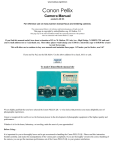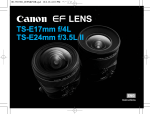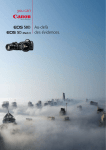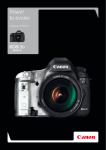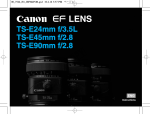Download Canon Speedlite 320EX
Transcript
EOS system Change your lens, change your story How to read MTF charts Performance 1 3 0.9 1 Key to icons Each EF lens is identified by a series of codes which provide important information about its characteristics. The symbols below are a quick reference guide to help you choose your lens based on the types of photography you do. 0.8 0.7 2 Making sense of lens names 4 0.6 0.5 0.4 0.3 0.2 100mm The focal length of the lens. A range of values indicates the maximum and minimum focal lengths of a zoom lens. f/2.8 The maximum aperture of the lens, expressed as an F-stop. The smaller the F-stop, the wider the maximum aperture. A range of values indicates the aperture at either end of the zoom range. L Indicates a professional L-series lens – the ultimate in image quality, durability and performance. IS Indicates that the lens uses an Image Stabilizer to correct for unwanted camera shake. IS allows shooting at up to five stops slower than would otherwise be possible. Dependant on the lens. USM Refers to Ultra Sonic Motor. Found in many Canon lenses, the USM drives fast, silent and accurate auto-focusing. Good for General Use Good for Close Up 0.1 Good for Portraits 0 0 5 (mm) Spatial frequency 10 15 20 Distance from centre of frame Maximum aperture S M Good for Sports f/8 S M 10 lines/mm Good for Indoor Sports 30 lines/mm The more the S and M curves are in line, the more natural the blurred image becomes 1 Contrast lines (thick lines) above 0.8 indicate superior contrast 2 Resolution lines (thin lines) above 0.6 indicate good sharpness 3 Lenses that demonstrate good edge performance have almost horizontal lines 4 The closer the Sagittal and Meridional lines are together, the more natural the blurred parts of an image appear An MTF (Modulation Transfer Function) chart indicates the resolution and contrast of a lens from the centre to the corner of an image both at the lens’ maximum aperture and at f/8. The graph is calculated from the lens’ ability to reproduce sets of extremely fine lines both parallel to the image diagonal (Sagittal) and perpendicular to the image diagonal (Meridional). One set of lines is spaced with 10 lines per millimetre (lpmm) and is used to indicate contrast. A second set, at 30 lines per millimetre, indicates resolution (sharpness). A Canon MTF chart is made up of 8 graph lines in two colours. The 4 black lines represent the lens’ performance at maximum aperture while the 4 blue lines indicate performance at f/8. Thick lines show contrast (10 lpmm) and thin lines resolution (30 lpmm). The lines representing sagittal detail are shown as solid lines. The lines representing meridional detail are shown dashed. For zoom lenses, charts are provided for both the minimum and maximum focal lengths. The perfect lens would show both solid and dashed lines running horizontally across the top of the chart – in other words, showing 100% accuracy throughout the frame. In practice no such lens exists, so you will see some amount of variance with even the very best lenses on the market. Good for Wildlife EF 100mm f/2.8L Macro IS USM Good for Landscapes Good for Products Other lens codes DO Uses Diffractive Optical elements Good for Architecture EF–S Designed for cameras with an EF–S lens mount Good for Interiors MP–E or Macro Designed for Macro photography Good for Travel II or III Lens version Lenses are sometimes replaced with improved models Good for Weddings ? Good for Reportage 1 ? Glossary 1 Tip i Information EOS system Change your lens, change your story ‘Village leader in traditional dress’ by Canon Ambassador Brent Stirton. Camera: EOS 5D Mark II Lens: EF 24mm f/1.4L USM Exposure: 1/200sec f/10 ISO speed: 50 Welcome Canon has been pushing the development of ground-breaking imaging technology forward for more than 70 years. From the production of the first ever high-quality cameras for the wider market, to the ongoing introduction of innovative medical imaging equipment and comprehensive professional printing technologies, the reliable and superior performance of Canon equipment has helped to make the company one of the world’s Best Global Brands ever since the first survey results were published in 2001.* Our photographers are amateurs, semiprofessional and professionals alike. They all have unique requirements for their cameras and lenses but have one thing in common: a passion for the power of image, and the stories that those images enable us to tell. * From the annual BusinessWeek Best Global Brands survey, ranked by Interbrand. © Brent Stirton/Reportage by Getty Images. Canon Ambassador. Canon photography Launched in 2008, Canon Europe’s Ambassadors Programme includes top professional photographers who are all passionate about the power of image. The Canon Ambassadors are committed and expert Canon users who are universally recognised for their high standards and are highly respected by fellow professionals. Below are some of those Ambassadors, alongside some semi-pro and amateur Canon photographers, who will be sharing their thoughts on some of our technologies throughout this brochure. How to use this brochure EF–S Lenses 18/19 EF–S 60mm f/2.8 Macro USM Paolo Pellegrin Canon Ambassador Documentary/Fashion Brent Stirton Canon Ambassador Photojournalism/ Environmental Portraiture Ideal fOr With its ability to focus life-size images onto the image sensor, the EF–S 60mm f/2.8 Macro USM offers true macro performance in the EF–S lens series. Having an effective focal length of approximately 96mm in 35mm format, it produces breathtaking close-up results. A minimum focusing distance of just 20cm gets you super close to your subject, filling the frame with the subject in the highest detail you require. aCCessOrIes • Lens Hood ET–67B • Soft Case LP1016 • 52mm Circular Polarizer PL–C B • 52mm Close-Up Lens 500D • 52mm Close-Up Lens 250D • Macro Ring Lite MR–14EX • Macro Twin Lite MT–24EX lens dIagraM MTF charts Modular Transfer Function charts accompany all of our lenses, to give you a deeper insight into how the lens performs. For more information, take a look at the inside front cover of this brochure. Richard Samaranch Betts, semi-pro, EOS 500D Richard has been using Canon cameras ever since he borrowed (repeatedly) a Canonflex from a friend as a teenager. After working as a TV cameraman for six years, it was only natural for Richard to be interested in images and photography. Inspired by unforgettable journeys and people he has met, he took up photography to document his travels. He uses photography to communicate feelings, situations, poetry, stories – and to capture moments of beauty. Nadine Kaegli, amateur, EOS 450D Nadine is continually inspired by both her home city of Zurich, Switzerland, and by the other places she travels to. She developed her passion for photography because it opened up the possibility of capturing special moments in her life in a creative way, so that she could share them with her family and friends. The ideal option for the highest image quality in sharpness and contrast 28–55 These lenses give you the freedom to switch perspectives in seconds 56–75 13 Lens diagrams Lens diagrams provide an illustration of the optics within a lens with special elements made from fluorite or ultra-low dispersion glass (UD) marked in different colours. Fergus Kennedy, semi-pro, EOS 7D UK national Fergus Kennedy is an award-winning wildlife photographer and marine biologist who developed a passion for the natural world at an early age. His work takes him around the world and his photographs have been published in a wide variety of magazines, newspapers and books. EF Fixed Focal Length EF Zoom Mtf Chart Jonathan and Angela Scott Canon Ambassadors Wildlife/Travel The smaller, lighter option with an extensive wide-angle choice 16–27 the ef–s 60mm f/2.8 Macro usM is the first true Macro lens in the ef–s series. a dynamic, compact, fast-focusing lens, it provides dramatic detail that goes beyond the human eye. EF–S 60mm f/2.8 Macro USM 1 0.9 0.8 0.7 0.6 0.5 0.4 0.3 0.2 0.1 0 0 5 10 Jeff Ascough Canon Ambassador Wedding EF–S Enter the macro world features • Approx. 96mm focal length (35mm format) • Compact and lightweight • High corner-to-corner resolution, contrast and image quality • Fast auto focus with near-silent USM • Full-time manual focus override • Super Spectra coatings • Large aperture Brutus Östling Canon Ambassador Wildlife The EF Lens 08–12 Choosing a lens 13–15 Product name The exact model name and number for the featured product. Accessories Our accessories are designed to enhance performance and your experience. Ideal for A quick look at what the lens is most commonly used for. Macro Make the most of the tiniest detail that even the human eye cannot capture unaided 76–85 Tilt and Shift Shift your perspective and plane of focus for accurate capture or creative effect 86–93 EOS System Accessories Expand your photography with a variety of accessories from remote controls to Speedlite flashes 94–113 Specifications A detailed summary of product specifications including accessory compatibility tables 114–123 Glossary A quick reference guide to some commonly-used technical terms 124–127 06/07 Choose Canon © Jonathan & Angela Scott. Canon Ambassadors. As established imaging experts, we’re proud to support the photography industry by sharing our experience and we celebrate its achievements in both professional and amateur image capture. The events and initiatives described opposite are just some of the activities that we are involved in, as a world leader in imaging technology. Camera: EOS–1Ds Mark III Lens: EF 70-200mm f/4L IS USM Exposure: 1/100sec f/4.0 ISO speed: 200 Promoting the power of image Highlighting the close relationship between the image-conscious world of fashion and photography, Canon has been an official sponsor of the Paris, Milan and London Fashion Weeks since 2006. Every year our Professional Services team offers a highly popular on-site loan, repair and maintenance service throughout the course of each Fashion Week. Celebrating photographic excellence The prestigious World Press Photo award celebrates the very best photography that documents major world events from the previous year. World Press Photo culminates during a weekend in Amsterdam, where the winners of each category present their work. Supporting professionals The Canon Professional Services (CPS) is an accessible, responsive, informative and customisable programme that offers extensive after-sales support and information for professional photographers and videographers. It’s free to qualifying Canon photographers and videographers. Sharing knowledge and expertise If you have a question about anything to do with your digital Canon equipment, visit our infobank at www.canon-europe.com/cpn 08/09 The EF lens The original EOS camera system was introduced to the world in 1987. At its heart was the EF lens mount, connecting lenses to the camera body in a fully electronic way for the first time. Apart from the physical connection between lens and camera body, all communication between these two key components is electronic, allowing for highly accurate, real-time data transfer. And because each lens has a unique performance characteristic, Canon became the first to build the motor that drives the focus inside each lens, rather than using a motor inside the camera body. 1946 Serenar 50mm f/3.5 Canon’s first ever lens. Serenar means ‘clear,’ symbolising the clarity that the development team was aiming for. 1961 50mm f/0.95 lens When this lens went on sale, it boasted the largest aperture of any photographic camera lens in the world. This legendary lens has gained a reputation as being brighter than the human eye, and further strengthened Canon’s international standing. Even with continued development and evolution of focus systems, Image Stabilizer technologies, lens element materials science, weather sealing and design, the original EF mount design remains unchanged. All EF lenses are compatible with every EOS camera ever produced, including the new digital EOS cameras. In 2011, Canon celebrated the cumulative production milestone of 60 million interchangeable EF lenses – 24 years since the launch of Canon’s EOS camera system and the EF lens mount. 1973 TS35mm f/2.8 SSC This was the first 35mm camera lens with tilt and shift functionality, and was ideal for architectural and commercial photography, which until then had been monopolised by largeformat view cameras. 1989 EF 50mm f/1.0L USM This standard lens featured the largest aperture of any 35mm SLR camera lens when first launched. The floating mechanism helped maintain high picture quality even at close focusing distances, while the electronic manual focus function allowed full-time manual focusing with a very light touch even in autofocus mode. Today, there are more than 60 EF lenses available, with focal lengths ranging from 8mm to 800mm and a range of specialist macro, tilt and shift and fisheye models. Professional photographers are catered for with the L-series EF lenses. With special optical elements, build quality and weather sealing, the L-series represents the pinnacle of Canon’s lens design. Matching advances in camera technology, EF lenses continue to evolve, including the introduction of leading technologies such as Diffraction Optics and Subwavelength Structure Coating to suppress and prevent the effect of reflections off digital camera sensors. The EF–S lens mount has been developed to take advantage of the compact APS–C sensor size of cameras such as the EOS 600D and EOS 7D, paving the way for a new range of compact, lightweight and high-quality lenses. 1999 EF 300mm f/2.8L IS USM This lens has achieved such a high reputation that it has come to be known as the symbol of Canon’s professional lenses. Its innovative performance has produced numerous classic photographs in the fields of sports, journalism, and advertising. 2008 EF 24mm f/1.4L II USM This is the first EF lens to employ the bio-mimetic Subwavelength Structure Coating (SWC) technology. SWC effectively minimises lens flare and ghosting caused by light hitting lens surfaces at large angles that is difficult to prevent using conventional coatings. 2001 EF 400mm f/4 DO IS USM The ultra telephoto EF 400mm f/4 DO (multilayered Diffractive Optical elements). IS USM lens turned the old ‘big and heavy’ image of telephoto lenses on its head, achieving a significantly lighter and more compact design than conventional models. 2009 EF 100mm f/2.8L Macro IS USM This lens is part of Canon’s prestigious L-series, and the first to feature an Image Stabilizer with angle and shift detection that is highly effective at close focusing distances. 10/11 The EF advantage What sets the EF lens range apart? Innovation. Canon has been pursuing the perfect lens for more than six decades. This pursuit has generated a raft of pioneering technologies, the very best of which are found in today’s line-up. Spherical aberration of spherical lens Aspherical lenses Canon was the first company to introduce aspherical elements for SLR lenses to counteract the problem of spherical aberration . These special elements play an integral part in delivering the corner-to-corner sharpness and clarity of top performers in the EF range. Convergence of parallel light rays by an Aspherical lens Fluorite and UD lens elements 球面レンズの球面収差 Fluorite crystal and Ultra-low Dispersion (UD) glass elements combat chromatic aberration or ‘fringing’. By virtue of their special diffraction properties, these materials keep colours accurate and contrast high. Lens coatings Light reflected off lens elements and the Diffractive optics image sensor can cause ghosting (secondary Canon is the first and only company in the images) and flare to appear in images. world to incorporate a Diffractive Optical (DO) Canon’s Super Spectra coating absorbs element into an interchangeable SLR lens. 球面レンズの球面収差 light rather than reflecting it. The new 非球面による焦点の一致化 This approach produces outstanding image Subwavelength structure coating (SWC) quality, but these lenses are significantly goes one step further, effectively eliminating lighter and smaller than similar the cause of problematic reflections to ensure conventional lenses. crisp, undistorted images. 非球面による焦点の一致化 Fluorite and UD lens elements keep colours accurate Inside an ultrasonic motor Ultrasonic Motor The Ultrasonic Motor (USM) was introduced with the Canon EF 300mm f/2.8L USM lens in 1987. Silent and accurate, USM technology powers the rapid auto focusing performance of almost every current EF lens. Canon’s Subwavelength Structure (SWC) Canon’s Subwavelength Structure (SWC) anti-reflective coating is what is known as a biomimetic technology – mimicking a phenomenon found in nature. Working at the nanoscale, the SWC coating is inspired by features found within the eyes of moths. Image Stabilizer Pioneered by Canon in 1995, Image Stabilizer technology uses gyro sensors to detect and compensate for unwanted camera shake. Today’s IS systems allow photographers to shoot up to 5 stops slower with no increase in blur. Since the image is stabilised within the lens instead of the camera, the IS system can be optimised for each model. What’s more, the auto focus system has a steady image to work with and the photographer gets a steady image through the viewfinder. Fluorine coating In 2010 Canon introduced a new coating for lenses elements. Using Fluorine with its tight molecule bond, this new coating provides a tough anti static surface that prevents dust and water from clinging to any exposed lens elements ensuring easier cleaning. 12/13 Fixed or Zoom? Zoom lenses offer several focal lengths within a single lens. Non-zoom or ‘prime’ lenses provide a single, fixed focal length. Each has its advantages. Zoom lenses The big benefit of a zoom lens is convenience. You can shoot wide or at longer focal lengths without having to change your lens mid-shoot. This is a factor to consider if you regularly shoot in time-sensitive situations. Having several focal lengths in one package also reduces the amount of equipment you’ll need to carry. Recent developments in lens technology are making zoom lenses more portable than ever before. The EF 70–300mm f/4.5–5.6 DO IS USM, for example, packs a wide zoom range into a unit that is less than 10cm long. Fixed lenses Fixed lenses generally offer a wider maximum aperture. You can shoot in lower light, or use faster shutter speeds when photographing action. If you like to shoot portraits, the shallow depth-of-field offered by fixed focal length lenses should be considered. Because they generally use fewer pieces of glass, fixed lenses are often sharper than their zoom counterparts at equivalent focal lengths. A fixed focal length lens is also a great learning tool when you are starting out because it forces you to think carefully about each composition, rather than simply zooming in on the subject. Super telephoto lenses are only available as prime lenses. The maximum focal length found in an EF zoom is 400mm, while prime lenses are available up to 800mm. Choosing a lens The following pages provide a general guide to suitable lenses for different situations. Ultimately, the right lens is the one that matches your creative vision. Sports and Wildlife For sports and wildlife photography, two factors are paramount: reach and speed. Whether you’re shooting lions on the Serengeti or weekend football players in thepark, you need a lens that gets up close yet allows you to keep your distance. Generally speaking, you should be looking at telephoto lenses between the 100mm–300mm focal length range. By speed, we mean lenses that focus quickly and transmit enough light to allow for very fast shutter speeds. A telephoto lens with a large maximum aperture will give you this capability. Portrait The best portraits are those that approximate our human interpretation of faces. In terms of focal length, that means anything between 50mm and 100mm. A wide-angle lens will accentuate extremities such as noses and ears. Telephoto lenses will flatten the face into something two-dimensional and uninspiring. Beyond focal length, a key consideration is maximum aperture. Wider apertures allow you to achieve finer depth-of-field . Distracting background detail is blurred and the focal point of your photograph – the subject’s face – remains in sharp focus. the professional’s choice: EF 300mm f/2.8L IS II USM GREAT BUDGET OPTION: EF 75–300mm f4-5.6 III USM the professional’s choice: EF 85mm f/1.2L II USM GREAT BUDGET OPTION: EF 50mm f/1.8 II The effects of camera movement are more noticeable at higher focal lengths. Most telephoto lenses feature Image Stabilizer (IS) technology to compensate for this. If you are shooting handheld without IS, follow the reciprocal rule: you need a shutter speed no slower than 1/focal length. So a focal length of 125mm would require a minimum shutter speed of 1/125. When choosing a portrait lens, look for a circular aperture. The shape of the aperture appears in out of focus highlights, and a circular aperture leads to more pleasing background blur. 14/15 Choosing a lens Focal length comparison The images below show the same scene taken from the same location with different focal lengths to show the effects that can be achieved with different lenses. Landscapes A wide-angle lens will allow you to get more of the scene into your photo while also giving a greater sense of depth and distance. Aim for a focal length between 17mm and 24mm, taking into account the crop factor for your camera. Most landscape photography requires a large depth-of-field to get as much of the scene as possible into focus. This means that typically, you do not require a large maximum aperture. What you do require is high quality optics to capture tiny details in your scene. the professional’s choice: EF 24mm f/1.4L II USM GREAT BUDGET OPTION: EF–S 15–85mm f/3.5–5.6 IS USM One way to increase magnification when shooting macro subjects is to add an extension tube between the camera and the lens . Extension tubes don’t have any glass in them – their purpose is to move the lens further away from the image sensor, thereby increasing magnification and Macro Macro lenses allow you to capture tiny objects at life-size. The main factor to consider when choosing a macro lens is the focal length. Shorter focal lengths (50mm–60mm) provide a wider field of view, which means you will typically be capturing more background detail in the image. Since you need to get right up close to your subject at these focal lengths, your working distance will be shorter. Medium or telephoto (90mm–180mm) macro lenses limit your field of view so that the subject can take up the entire frame. You can shoot from a greater distance – useful when photographing skittish insects (see page 78–79 for an indepth tutorial). the professional’s choice: EF 100mm f/2.8L Macro IS USM GREAT BUDGET OPTION: EF–S 60mm f/2.8 Macro USM allowing for a closer working distance. The trade-off is that you lose the ability to focus to infinity. Architecture and Interiors Perspective distortion is a common problem when photographing buildings. The lines of a building tend to converge when photographed, resulting in a slightly skewed final image. A Tilt and Shift lens is a good solution. This is a specialist lens that allows you to shift the lens axis away from the centre of the frame. The vertical edges remain parallel, achieving the same effect as specialist view cameras. Another benefit is that the field of view is much wider than would be possible using a normal lens of the same focal length. (See page 88–89 for an in-depth tutorial on using Tilt and Shift lenses). the professional’s choice: TS–E 17mm f/4L GREAT BUDGET OPTION: EF–S 10–22mm f/3.5–4.5 USM Ultra wide-angle lenses (such as the EF 14mm f/2.8L II USM) are unsuitable for interior photography since images at these focal lengths often show barrel distortion at the edges of the frame, with straight lines appearing curved. You can, however, correct much of this distortion through the lens aberration correction feature in Digital Photo Professional software. 8mm 14mm 15mm 20mm 24mm 28mm 35mm 50mm 85mm 100mm 135mm 200mm 300mm 400mm 600mm 800mm 16/17 EF–S Lenses EF–S lenses are specifically designed for EOS models with a compact sensor – delivering lenses that are lightweight, versatile and supremely portable. With the EF–S range, Canon’s engineers took advantage of the APS–C sensor size to produce lenses that are not only lighter and smaller, but also offer photographers far greater wide-angle choice. Lenses such as the EF–S 55–250mm f/4–5.6 IS take the range much further. Owners of EF–S mount cameras now have access to a complete offering of lightweight lenses extending from 16mm to 400mm (35mm equivalent). CANON semi-pro Richard SAMARANCH Betts “I came back to Ferrera because I always wanted to document what was going on here. I lived here many years ago, and it was an amazing experience to live in this countryside in these mountains with the people here and I wanted to capture that. In this area there are no shepherds left except for Ramon. We first met when I was 20 and he was 19. The benefit of a high ISO sensitivity rating means I can shoot freely in low light, I don’t have to use flash and can capture my subject in its setting where the light is low but also beautiful.” Camera: EOS 500D Lens: EF–S 18–55mm f/3.5–5.6 IS Exposure: 1/100sec f/6.3 ISO speed: 100 EF–S Lenses 18/19 IDEAL FOR features • Approx. 96mm focal length (35mm format) • Compact and lightweight • High corner-to-corner resolution, contrast and image quality • Fast auto focus with near-silent USM • Full-time manual focus override • Super Spectra coatings • Large aperture EF–S 60mm f/2.8 Macro USM EF–S 10–22mm f/3.5–4.5 USM Enter the macro world A new perspective The EF–S 60mm f/2.8 Macro USM is the first true Macro lens in the EF–S series. A dynamic, compact, fast-focusing lens, it provides dramatic detail that goes beyond the human eye. An ultra wide-angle zoom lens with dynamic expressive capability for all EF–S mount EOS cameras; exceptionally small and lightweight for maximum mobility. With its ability to focus life-size images onto the image sensor, the EF–S 60mm f/2.8 Macro USM offers true macro performance in the EF–S lens series. Having an effective focal length of approximately 96mm in 35mm format, it produces breathtaking close-up results. A minimum focusing distance of just 20cm gets you super close to your subject, filling the frame with the subject in the highest detail you require. With its effective focal length range of approximately 16–35mm in 35mm format, the EF–S 10–22mm f/3.5–4.5 USM is a remarkable lens with outstanding image quality that will take your photography into new dimensions and areas of dramatic expression. ACCESSORIES • Lens Hood ET–67B • Soft Case LP1016 • 52mm Circular Polarizer PL–C B • 52mm Close-Up Lens 500D • 52mm Close-Up Lens 250D • Macro Ring Lite MR–14EX • Macro Twin Lite MT–24EX IDEAL FOR features • Super wide angle zoom for all EF–S mount bodies • Superb image quality • Lightweight and compact • Focusing distance of just 24cm • Fast near-silent USM AF • Super Spectra coatings • Circular aperture • Optional exclusive lens hood ACCESSORIES • Lens Hood EW–83E • Soft Case LP1319 • 77mm Circular Polarizer PL–C B • 77mm Close-Up Lens 500D mtf chart EF–S 60mm f/2.8 Macro USM 1 0.9 0.8 0.7 0.6 0.5 0.4 0.3 0.2 0.1 0 0 5 10 lens diagram 13 mtf chartS EF–S 10–22mm f/3.5–4.5 USM WIDE 1 0.9 0.8 0.7 0.6 0.5 0.4 0.3 0.2 0.1 0 0 5 10 13 lens diagram EF–S 10–22mm f/3.5–4.5 USM TELE 1 0.9 0.8 0.7 0.6 0.5 0.4 0.3 0.2 0.1 0 0 5 10 13 EF–S Lenses 20/21 EF–S 15–85mm f/3.5–5.6 IS USM EF–S 17–55mm f/2.8 IS USM The high performance, all-round standard zoom lens Change your view. Not your aperture Combining an extensive zoom range featuring wide angle and telephoto plus a 4-stop Image Stabilizer, the EF–S 15–85mm f/3.5–5.6 IS USM provides outstanding performance and flexibility. With a constant f/2.8 aperture throughout the zoom range and a three-stop Image Stabilizer, the EF–S 17– 55mm f/2.8 IS USM provides outstanding performance and framing flexibility in low light conditions. With an effective focal length range of approximately 24–136mm (35mm equivalent), the EF–S 15–85mm f/3.5–5.6 IS USM is a lens that delivers outstanding flexibility while delivering remarkable image quality. With its wider angle than many comparable lenses, it captures more of the scene and adds a greater sense of space and perspective to your photography. With an effective focal length range of approximately 27–88mm (35mm equivalent), the EF–S 17–55mm f/2.8 IS USM is a powerful lens that delivers remarkable image quality. The wide angle zoom allows you to capture more of every scene and adds a new sense of space and perspective to your photography. IDEAL FOR features • High performance all-purpose 5.6x 24–136mm equivalent EF–S standard zoom • Four-stop Image Stabilizer • Automatic panning and tripod detection • 0.35m close focusing • UD and aspherical lenses • Super Spectra coatings • 7-blade aperture • Optional lens hood ACCESSORIES • Lens Hood EW–78E • Soft Case LP1116 • 72mm Circular Polarizer PL–C B • 72mm Close-Up Lens 500D lens diagram IDEAL FOR features • Wide angle zoom for EF–S mount bodies f/2.8 aperture throughout zoom range • Three-stop Image Stabilizer • Fast, quiet auto focus • Super Spectra coating • Circular aperture for pleasing background blur • Passes distance information to E–TTL II • Optional lens hood ACCESSORIES • Lens Hood EW–83J • Soft Case LP1219 • 77mm Circular Polarizer PL–C B • 77mm Close-Up Lens 500D mtf chartS EF–S 15–85mm f/3.5–5.6 IS USM WIDE 1 0.9 0.8 0.7 0.6 0.5 0.4 0.3 0.2 0.1 0 0 5 10 mtf chartS EF–S 15–85mm f/3.5–5.6 IS USM TELE 1 0.9 0.8 0.7 0.6 0.5 0.4 0.3 0.2 0.1 0 0 5 10 EF–S 17–55mm f/2.8 IS USM WIDE 1 0.9 0.8 0.7 0.6 0.5 0.4 0.3 0.2 0.1 0 0 5 10 13 lens diagram EF–S 17–55mm f/2.8 IS USM TELE 1 0.9 0.8 0.7 0.6 0.5 0.4 0.3 0.2 0.1 0 0 5 10 13 EF–S Lenses 22/23 IDEAL FOR features • Exceptional zoom range for all EF–S mount bodies • Superb image quality • Lightweight and compact • Image Stabilizer – up to three stops compensation • Fast near-silent USM AF • Super Spectra coatings • Circular aperture • Optional lens hood EF–S 17–85mm f/4–5.6 IS USM EF–S 18–55mm f/3.5–5.6 IS II One lens. Many possibilities Versatile, compact zoom lens Real freedom of framing in a lightweight, compact and fast-focusing lens. The EF–S 17–85mm f/4–5.6 IS USM is an excellent all-purpose lens for EF–S mount EOS cameras. Compact and affordable, the EF–S 18–55mm f/3.5–5.6 IS II is an ideal general-purpose standard zoom. Its four-stop Image Stabilizer provides great performance in low-light conditions. The EF–S 17–85mm f/4–5.6 IS USM provides an effective focal length range of approximately 27–136mm in 35mm format. This provides plenty of framing options, making it the perfect all-rounder lens that allows you to express your creativity in a vast range of shooting situations. The EF–S 18–55mm f/3.5–5.6 IS II is a high-quality, standard zoom lens that will appeal to photographers who prefer to travel light. With a focal length equivalent of 29–88mm in 35mm format, the lens’ wide zoom range is suitable for most general photography. For close-up work, the working distance is just 0.25m (25cm) throughout the zoom range. IDEAL FOR features • Lightweight, compact design • Wide-angle to short telephoto range • Four-stop Image Stabilizer • Aspherical lens elements for control over distortion • 0.25m close-focusing distance • Super Spectra coatings • Circular aperture diaphragm • High-speed AF ACCESSORIES • Lens Hood EW











































































